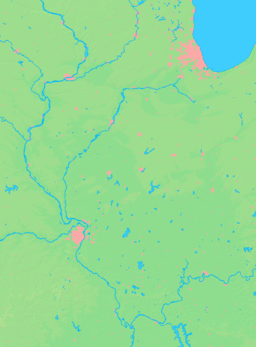Kingston, Illinois
| Kingston | |
| Village | |
| Country | United States |
|---|---|
| State | Illinois |
| County | DeKalb |
| Coordinates | 42°6′0″N 88°45′43″W / 42.10000°N 88.76194°WCoordinates: 42°6′0″N 88°45′43″W / 42.10000°N 88.76194°W |
| Area | 1.02 sq mi (3 km2) |
| - land | 0.99 sq mi (3 km2) |
| - water | 0.02 sq mi (0 km2) |
| Population | 1,164 (2010) |
| Density | 976.9/sq mi (377/km2) |
| Timezone | CST (UTC-6) |
| - summer (DST) | CDT (UTC-5) |
| Postal code | 60145 |
| Area code | 815 |
  Location of Kingston within Illinois | |
| Wikimedia Commons: Kingston, Illinois | |
Kingston is a village in DeKalb County, Illinois, United States. The population was 1,164 at the 2010 census, up from 980 in 2000.
History
Settled in 1835 by the Pottawatomie Indians, Kingston was one of the first townships in DeKalb County. The post office was established in 1837 with Levi Lee as postmaster. With the post office started and the building of the Chicago, Milwaukee and St. Paul railroad the settlement of Kingston grew. It became a prosperous village after 1876 when the Stuart brothers, James and Lyman, platted the town. Both men built houses in 1876, both out of brick and both are still standing today. James built the house at 501 S. Main Street and Lyman built the house at 300 S. Main Street. Kingston officially became a Village in 1886.
With Kingston being a major "hub" for two railroads business flourished throughout the area. By the 1900s Kingston had many businesses including; a hardware store, department store, grocery, meat market, paint shop, hotel, bank, bakery, shoe store, barber shop, pool room, saloon, general store, creamery, undertaking parlor, saw mill, coal and lumber yard, two blacksmith shops, two livery barns, stock yards and two confectionaries. Kingston even had its own baseball team, The Kingston Tigers. Some of the businesses mentioned above were destroyed in the fire of 1908, which engulfed a large part of town on the west side of Main Street.
W. H. Bell, an early resident of Kingston, instigated the first Kingston Picnic while he was Village President. The picnic was held every year and in 1912, when The Kingston Township Park opened, the picnic had a permanent home. The annual Kingston Picnic was held for over 100 years and celebrated its centennial in 1976.
Geography
According to the 2010 census, Kingston has a total area of 1.015 square miles (2.63 km2), of which 0.99 square miles (2.56 km2) (or 97.54%) is land and 0.025 square miles (0.06 km2) (or 2.46%) is water.[1]
Demographics
| Historical population | |||
|---|---|---|---|
| Census | Pop. | %± | |
| 1880 | 138 | — | |
| 1890 | 295 | 113.8% | |
| 1900 | 305 | 3.4% | |
| 1910 | 294 | −3.6% | |
| 1920 | 235 | −20.1% | |
| 1930 | 242 | 3.0% | |
| 1940 | 259 | 7.0% | |
| 1950 | 327 | 26.3% | |
| 1960 | 406 | 24.2% | |
| 1970 | 481 | 18.5% | |
| 1980 | 618 | 28.5% | |
| 1990 | 562 | −9.1% | |
| 2000 | 980 | 74.4% | |
| 2010 | 1,164 | 18.8% | |
| Est. 2015 | 1,155 | [2] | −0.8% |
As of the census[4] of 2000, there were 980 people, 328 households, and 251 families residing in the village. The population density was 976.9 people per square mile (378.4/km²). There were 338 housing units at an average density of 336.9 per square mile (130.5/km²). The racial makeup of the village was 96.43% White, 0.10% African American, 0.41% Native American, 0.20% Asian, 2.35% from other races, and 0.51% from two or more races. Hispanic or Latino of any race were 6.53% of the population.
There were 328 households out of which 46.3% had children under the age of 18 living with them, 64.0% were married couples living together, 8.5% had a female householder with no husband present, and 23.2% were non-families. 17.7% of all households were made up of individuals and 4.6% had someone living alone who was 65 years of age or older. The average household size was 2.94 and the average family size was 3.37.
In the village the population was spread out with 33.6% under the age of 18, 6.3% from 18 to 24, 37.6% from 25 to 44, 17.1% from 45 to 64, and 5.4% who were 65 years of age or older. The median age was 31 years. For every 100 females there were 105.5 males. For every 100 females age 18 and over, there were 112.7 males.
The median income for a household in the village was $55,179, and the median income for a family was $58,929. Males had a median income of $43,000 versus $28,083 for females. The per capita income for the village was $21,432. About 4.2% of families and 4.8% of the population were below the poverty line, including 6.1% of those under age 18 and 17.6% of those age 65 or over.
Government
Kingston is governed by a part-time Village President and six-member Board of Trustees. The president and trustess serve four-year terms and are elected at large. The terms of the trustees are staggered such that half the Board is elected every two years. The current Board of Trustees is as follows (expiration of current term indicated in parentheses):
- John Munro, Village President (2009)
- Jim Baenziger (2007)
- Jennifer Butler (2007)
- John (Jack) Fischer (2009)
- Joe Hengels (2009)
- Steve Nece (2007)
- Robert Ruehl, Jr. (2009)
The Village Clerk and Village Treasurer are appointed by the Board of Trustees. The current Clerk is Kristin Hillner and the current Treasurer is Taunya Fischer.
Schools
Kingston is part of the Genoa-Kingston (GK) School District with nearby Genoa. The district has 3 Public Elementary schools: Davenport Elementary School (Grades K-1) and Genoa Elementary School (Grades 4-5) located in Genoa and Kingston Elementary School (Grades 2-3) located in Kingston. In addition, Genoa is home to the Genoa-Kingston Middle School (Grades 6-8) and the Genoa-Kingston High School (Grades 9-12). The GK School District's team name is the Cogs, an acronym created from the phrase "Community of Genoa Schools" that also evokes a feeling of teamwork not unlike the cogs in a machine.
Notable people
- Isaiah Stillman, militia commander during Black Hawk War, died in Kingston.
References
- ↑ "G001 - Geographic Identifiers - 2010 Census Summary File 1". United States Census Bureau. Retrieved 2015-08-04.
- ↑ "Annual Estimates of the Resident Population for Incorporated Places: April 1, 2010 to July 1, 2015". Retrieved July 2, 2016.
- ↑ "Census of Population and Housing". Census.gov. Retrieved June 4, 2015.
- ↑ "American FactFinder". United States Census Bureau. Retrieved 2008-01-31.